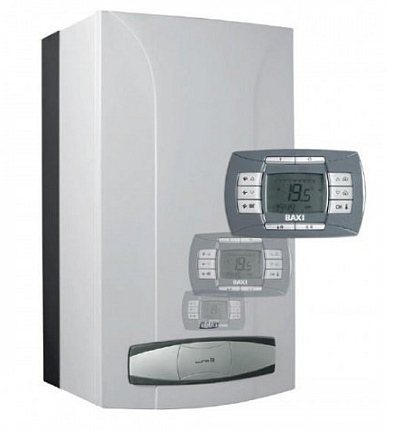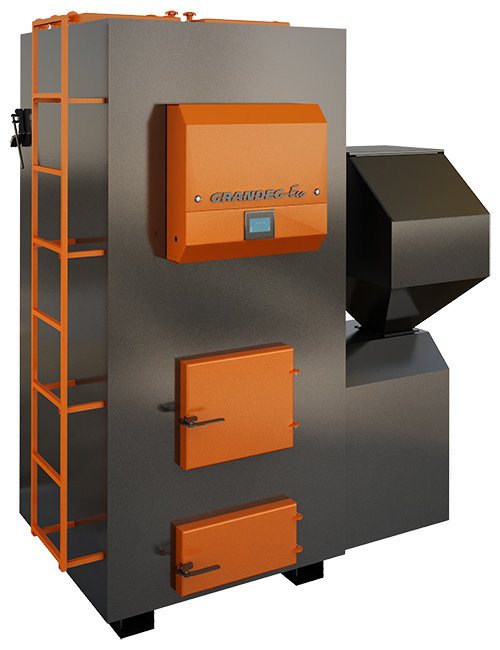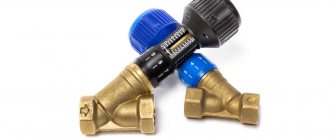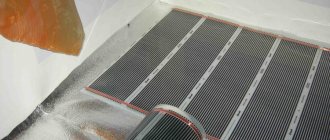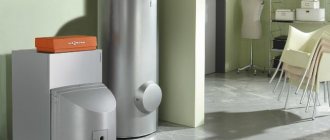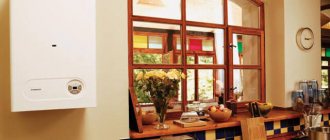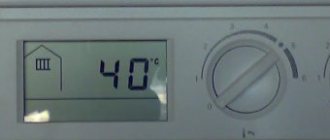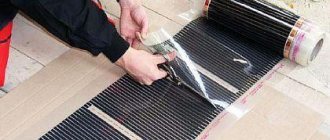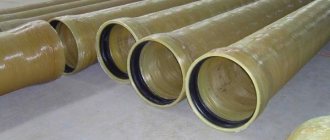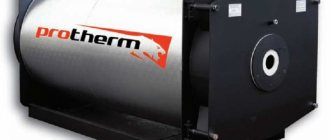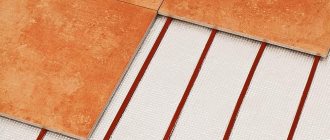When a turbocharged boiler is operating, air consumption and combustion products are emitted from the street. The process involves a smoke exhauster and a coaxial chimney consisting of two pipes, with one of them inserted into the other. This method of air removal and intake has a number of advantages and disadvantages. For example, in winter, icing of a coaxial chimney occurs.
Let's consider the signs of icing of a coaxial chimney and methods to ensure its normal operation in winter.
Types of coaxial type chimneys
There are several types of “pipe-in-pipe” construction. Let's look at each of them in detail.
External and internal systems
All coaxial chimneys, depending on their location, are divided into external and internal. The first are located on the outside of the building and are fixed directly to the facade.
Considering that such structures somewhat spoil the appearance of the building, they try to place them on the inner sides of the building. A distinctive feature of an external type chimney is its ease of maintenance and installation.
Internal structures are mounted in specially laid shafts that run inside the building and are separated from the living quarters. In some cases, traditional chimneys can be used as such shafts.
It is important that their design and dimensions fully comply with modern fire safety requirements. Internal systems are quite complex to maintain and install.
Non-insulated and insulated devices
In cold weather, especially in severe frosts, the channel supplying air to the system may freeze. In this case, the amount of oxygen entering the combustion chamber sharply decreases, which leads to deterioration in the operation of the heating device.
In some cases, even to its stop. Therefore, where low temperatures last for a fairly long period of time, as well as where severe frosts are common in winter, it is recommended to install insulated systems.
Insulated coaxial chimneys are distinguished by the presence of another pipe. A layer of non-flammable heat insulator is placed between it and the external part, which prevents the structure from freezing
The insulated coaxial chimney differs from the standard one by the presence of one more pipe. The system looks like three parts nested inside each other.
The free space between the two extreme elements is insulated. For this purpose, it is filled with any suitable insulation. This reliably protects the air channel from icing and freezing.
Horizontal or vertical output
Initially, coaxial chimneys were developed as horizontally oriented systems, but in practice such an arrangement is not always possible. Most chimneys of this type are mixed structures.
They may contain both vertically oriented and horizontal sections. This is due to the location of the heating device in the building. In some cases, it is possible to use vertical chimneys, but only for boilers without forced draft.
Collective and individual designs
To service one heating device, individual coaxial chimneys are used. These are simple systems without branches that can have different configurations.
To work with several boilers, a collective chimney is installed. This is a mine system with several branches. In this case, each of the branches goes to one of the heat generators. This design can only be vertical.
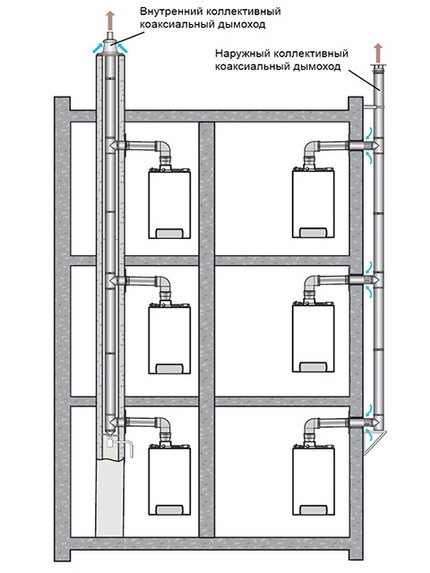
A collective chimney of the coaxial type is characterized by the presence of several heat generators connected to one shaft. Can be both external and internal
Why choose coaxial systems?
The design features of a coaxial type chimney give it the opportunity to work on a principle different from a traditional chimney. To ensure combustion, oxygen must be supplied to the boiler furnace and combustion products must be removed.
Boilers equipped with separate chimneys take air from the room in which they are installed. This is quite dangerous for humans and requires constant ventilation of the room.
Exhaust gases are discharged outside through natural draft. Appliances with coaxial chimneys work differently. Such chimneys are a combined system of air supply and smoke removal.
The draft necessary for the operation of the device is created naturally or with the help of a fan, which allows the use of small structures.
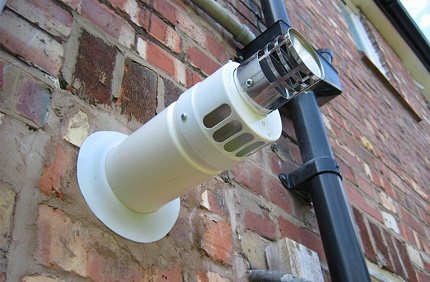
A significant advantage of chimneys of coaxial design is ease of installation and the ability to remove combustion products via the nearest route, for example, through a wall
Thus, complete isolation of the exhaust of combustion products and the supply of oxygen makes it possible to completely eliminate their impact on the composition of the air in the room where the boiler is installed.
There is no “burning out” of oxygen, as a result of which there is no need to ventilate the room. The amount of air in the combustion chamber is optimal, which increases the percentage of fuel combustion and, as a result, the boiler operates more efficiently and environmentally friendly.
Hot smoke from the heating device is discharged through the internal pipe. It passes inside another, through which cold air moves. Thus, there is no thermal effect on the walls and ceilings within which the chimney is laid.
This significantly increases its fire safety, which is very important for buildings made of wood and other fairly flammable materials.
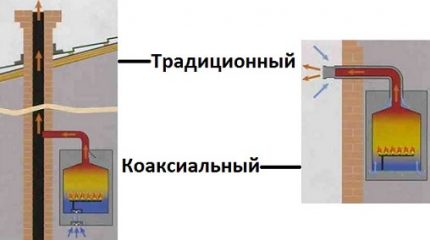
The figure schematically shows the main difference between coaxial chimneys and traditional ones. The first takes air outside, the second takes air indoors, which is dangerous for those who are in it
The coaxial system increases the efficiency of the heating device. This occurs due to the fact that the air supplied to the firebox, passing through the internal cavity of the structure, is heated from the pipe that removes hot smoke.
Another significant advantage of chimneys of this type is their compactness and relatively small size, especially compared to traditional chimneys.
It would be a mistake to think that the system has no flaws. They are. First of all, this is the rather high cost of such a design. On average, it is 40% more expensive than the traditional one. Another one is due to the design of a coaxial type chimney.
Pipes with hot smoke and cold air come into contact, which inevitably leads to the formation of condensation, especially in cold weather. Thus, the system requires a special drain for condensate and additional insulation, which further increases its cost.
How to calculate and select correctly?
Considering that heating equipment has different power, the size of the firebox requires certain volumes of oxygen to ensure the required combustion intensity, and it also releases different amounts of combustion products. Therefore, the selection of a coaxial chimney for a specific boiler must be done individually.
To make the correct selection, you need to make certain calculations and take into account the following important factors:
— type of fuel on which the device operates;
— boiler power;
— average range of fluctuations in street temperatures;
— level of wall insulation;
- power of the heating device;
— total power indicator (for universal boilers);
- the degree of tightness of the premises and in particular the area in which the boiler will be installed.
The choice cannot be made in a hurry. This will lead to loss of time and money, and a decrease in the efficiency of the boiler. Therefore, you first need to draw up a plan for the route of the future chimney. Determine all the structural elements required to create it. Take measurements. When performing this work, the following important points must be taken into account:
- the length of its outer part should not be less than 25 cm;
- for each boiler model it is necessary to purchase suitable connection elements;
- if there is a risk of freezing temperatures, it is necessary to provide insulation for the chimney;
- the design must comply with established standards.
When planning the installation of a chimney of this type, you should, by calculation, anticipate what size product will be optimal for a particular boiler.
This is done according to the formula - F = (K * Q) / (4.19 * √H)
Where:
- F is the cross-sectional diameter of the outlet;
- K - constant coefficient - 0.02–0.03;
- Q is the maximum power of the heating device, in kJ/h. Data can be found in the equipment specification;
- H is the designed height of the chimney.
Features of choosing device size
The technical documentation that comes with the chimney must indicate its diameter. The designation consists of two numbers written through a fraction.
The first of them shows the diameter of the inner pipe, the second – the outer one. Finding the right size is quite simple. It must be indicated in the passport of the boiler that will be connected to such a chimney.
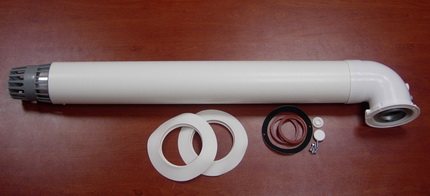
The dimensions of the coaxial type chimney are selected in strict accordance with the type of boiler and the dimensions of its boiler outlet pipe. All necessary information should be in the technical documentation of the heating device
The determining indicator in this case will be not only the diameter of the system, but also its length. The latter is defined as the sum of the lengths of all sections of the chimney.
It has limitations stated in the installation instructions and is measured in equivalent meters. In addition, all these nuances are indicated in the selection table, which should be attached to the technical documentation of the heating equipment.
Brief summary
A boiler with a coaxial chimney is more efficient and safe to operate compared to traditional solutions. It does not require more care than normal. In addition, its maintenance is not a complicated procedure that requires any special knowledge and tools. The device does not take up much space and is quite easy to install. It won't be difficult to find one. A wide variety of products in the retail network allows this to be done. Using a fairly simple formula, you can calculate what diameter the outlet connection hole of the product should have.
Video on the topic:
Installation of a chimney in the light of regulations
A coaxial smoke exhaust system can be installed in a private or apartment building. The latter is also quite common, especially in connection with the widespread installation of individual heating systems in apartments.
Until 2012, the design and installation of coaxial type chimneys in apartment buildings and private buildings were regulated by one SNiP and did not differ.
SP 60.13330.2012 was adopted , which is an updated version of SNiP 41-01-2003 . The document divided the conditions for installing a coaxial chimney in an individual and apartment building. In the latter case, it is prohibited to install individual chimneys in apartments, as was previously permitted, and the installation of a collective chimney is prescribed.
Therefore, you need to be very careful and know that if designers propose to arrange an individual exhaust gas outlet from a heat generator located in one of the apartments of an apartment building, this is contrary to current standards.
The distance from the ridge of the roof of the building to the section of the smoke exhaust duct must be at least 1.5 m. The same value for a private house is from 0.5 m.
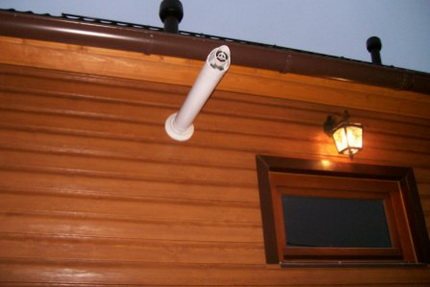
The outlets of coaxial chimneys must be located at a sufficient distance from the windows, otherwise smoke will enter the room
No special acts regarding individual buildings have been adopted, therefore it is believed that their arrangement should not contradict the requirements applied when installing chimneys in apartment buildings. Based on the new edition of SNiP, coaxial systems of any type can be installed in private houses. In apartment buildings - only vertical ones.
An important nuance. If smoke vents were installed in a building before 2012 that contradict the current edition, they can be left unchanged if they do not cause inconvenience to neighbors. Read more about the standards for installing a coaxial chimney below.
Necessary materials
If you are going to install a coaxial chimney yourself, what will this require of you?
To install a coaxial chimney, you will definitely need a coaxial chimney kit, which includes the pipe itself, an elbow, an adapter and clamps. If necessary, purchase a coaxial pipe extension.
If you need to install a vertical coaxial chimney, it will be installed through the roofing and the roof itself. To maintain the structure in a vertical position, use an adapter. Note! Adapters are designed only for specific equipment. Only those recommended by the manufacturer should be used.
It is required that the required length of the coaxial chimney be achieved; for this, special extensions are used. To achieve tightness of the passage through the roofing part, a special device is used - the so-called terminal.
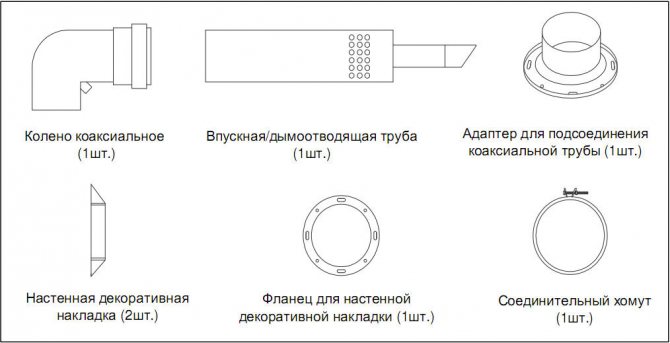
Accessories for installing a coaxial chimney
Such chimneys are made of steel (either galvanized or stainless steel), aluminum alloys or special heat-resistant plastic. Such materials, in addition to their strength and lightness, also have increased resistance to high temperatures. Often the inner side of the pipe is made of aluminum alloy, and the outer side is steel. Its thickness is 1/1.5/2 mm.
When installing a coaxial chimney with your own hands, you must observe the following installation rule: the height of the outlet pipe above the device must be at least one and a half meters, and the pipe must be located with an inclination of approximately 3º so that the condensate can flow down unhindered. It is also advisable to maintain a distance of at least 1-1.5 m between the ground surface and the chimney outlet. When installing a complex system, the length of the coaxial chimney should be about 3 m.
Some installation features
For each boiler, the direction of the channel discharging combustion products is determined individually. Horizontal systems can only be used for devices with forced ventilation.

Errors in calculations and installation can lead to freezing of the system and freezing of condensate at the outlet. In such conditions the boiler will not be able to operate.
But even in this case, the maximum length of such a section should not be more than 3 m. It happens that the manufacturer sets other standards for its boilers, so you should familiarize yourself with the technical documentation of the device.
Vertical-type structures for private houses are used only if there are reasons that prevent the smoke exhaust duct from exiting through the wall.
This could be windows located close to the outlet pipe, a narrow street on which the building is located, and the like. In some cases, if it is very necessary, an inclined installation of a coaxial chimney pipe is allowed.
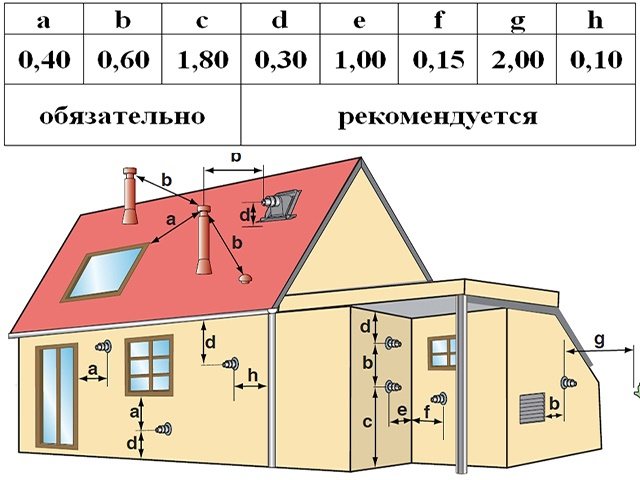
Options for the passage of a coaxial chimney through building structures and the distance between the chimney and the elements of the house are given based on many years of operating practice
The system is connected to the heating device using a tee, elbow or pipe. In this case, the diameters of the outlet channel and the boiler outlet must be the same.
During the installation process, all subsequent parts are fixed in the preceding ones so that no obstacles are formed that could disrupt the movement of combustion products. The number and type of elements for assembly directly depend on the location of the outlet pipe.
If it is located on the side, a horizontal system is assumed, if on top - a vertical one. The latter option is easier to install.
In the process of arranging a coaxial chimney, transition units are necessarily used with rigid fastening of the junction areas of two elements using clamps. Some “craftsmen” prefer to use homemade options.
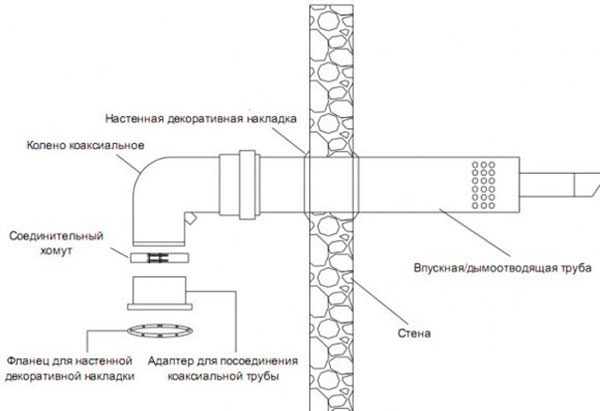
The figure shows a diagram of the arrangement of the passage of a horizontal coaxial chimney through a wall
These can be adapters made by yourself, tape windings or sealant seals. Such things are unacceptable to use because they are extremely unreliable. A system assembled using such elements is considered unsafe to operate.
In addition, the following rules are observed during the installation process:
- The section of the horizontal chimney going outside should be inclined 3° downwards. The horizontal section of the chimney entering the common section is inclined in the opposite direction, that is, it decreases towards the boiler. This is necessary for unimpeded drainage of condensate.
- There should be no more than two bends along the entire length of the chimney duct.
- Inspection hatches, adapters and a device for discharging condensate must be easily accessible for periodic inspection.
- The chimney cannot be installed below ground level. In this case, the distance from the outlet of the coaxial chimney to the neighboring building must be more than 8 m. If a deflector is installed on the pipe, this distance is reduced to 2 m for a blank wall and 5 m for a wall with window openings.
- If a horizontal chimney is installed in a place where winds prevail, the direction of which is opposite to the direction of smoke removal, a sheet metal barrier must be installed at the pipe outlet. The distance between it and the outlet must be at least 0.4 m.
- On coaxial chimneys rising less than 1.8 m above ground level, it is necessary to install a deflector grille. It will work as protection against hot smoke.
All structural elements must fit tightly to each other. Each subsequent part must fit inside the previous one at a distance equal to at least half the diameter of the channel cross-section.
To guide the structure around any obstacle, bends specially designed for this purpose are used. Their angle of inclination may be different. If the system is vented through the roof, all fire safety requirements must be met.
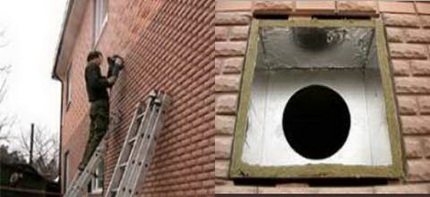
The arrangement of the passage of a coaxial chimney through the roof or through a wall must be carried out in strict compliance with all fire safety requirements
For this purpose, special insulating pipes and non-flammable insulating materials are used. There must be an air gap between the pipe and the ceiling.
To avoid contact between the smoke exhaust duct and fragments of the roofing pie, a protective casing is used. The exit of the structure through the roof is carefully sealed. The joint areas are covered with a special apron.
Main varieties
Gas floor-mounted chimney boilers can have different technical and operational characteristics, based on which they are divided into the following categories:
| Varieties | Description |
| Gas
| Chimney floor-standing gas boilers are distinguished by their efficiency and versatility of use. There is no need to use fuel for their operation and kindling, and installation does not require approval from gas services if the appropriate documentation and certificates are available. |
| Pellet
| The kindling of pellet models is done by hand. To operate and function, you will need purchased pellets. The price for this variation, unlike gas modifications, is several times more expensive. |
Important:
floor-standing chimney gas boilers have a large mass and medium dimensions. If the space for installing such equipment is limited in area, we recommend that you pay attention to similar wall-mounted models.
Interesting to know:
gas floor-standing chimney boilers are installed not through the roof and roof, but through the wall. In order for the traction mechanism to work properly and at full strength, it is recommended to use only the fittings and additional parts included in the kit. It is equally important to equip such a chimney with a fan. Also pay attention to the tightness of each chimney joint and the structure itself. Before starting installation, make sure that the cross-sectional size and diameter of the pipes coincide with similar elements of the outlet. When installing from the outside of the building, take care of its thermal insulation.
Basics of installation work
A chimney for a floor-standing gas boiler requires proper and correct installation work. In this case, the following instructions will help you:
- To select the appropriate diameter, you need to find out the power of the heating unit, and also take into account climatic conditions and average temperatures in summer and winter. It is also important what materials the house itself is made of;
- If the circulation system is forced, only a horizontal arrangement of the chimney system is allowed. If such an arrangement is not possible, it is permissible to install it in a vertical arrangement through the roof and roof;
- During the installation process, you will need such parts and accessories as: flange, clamp, elbow, adapter, trims for decoration;
It is possible to connect several boilers at once

Basic elements of a heating installation
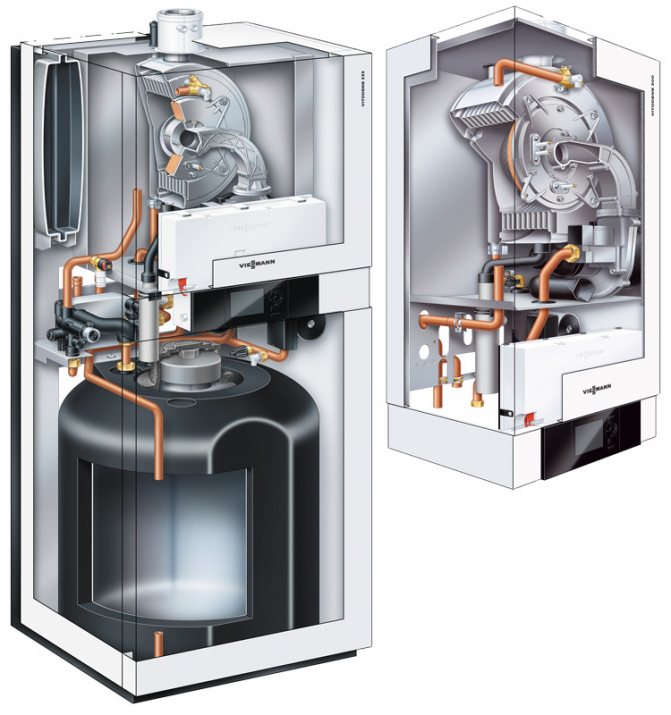
Floor-standing models are bulky and heavy
- To ensure that condensate does not accumulate and is removed in a timely manner, the chimney design may have areas with a small angle of inclination;
- To exit the chimney system, as a rule, an external wall is taken, located horizontally;
- The length of the structure is no more than 2-3 meters;
- To collect condensate, a special collector is installed in the inner surface of the pipe;
- The angle of inclination of the pipes can reach thirty degrees;
- the pipe outlet must be located at a height of at least 160 centimeters above the boiler itself;
- The outlet hole will be slightly larger in diameter than the chimney pipe itself. This will prevent clogging of the inner surface of the hood.
Tip: since coaxial chimneys include two pipes at once, there is no need to insulate them yourself, since they will not freeze even in winter.
Important: despite all the advantages, such boilers also have a number of disadvantages. First of all, this is the high cost, as well as the difficulties arising as a result of the breakdown or failure of such equipment. Even the best service center can take several weeks to repair and replace individual parts.
Professionals take as a basis the standards and requirements described and specified in SNiP 2.04.08 (87). The heat generator in this case can be either gas equipment or a convector or radiator.
Coaxial chimney installation technology
The installation process for external and internal coaxial chimneys is different. Let's consider both options.
Installation of the internal system
First of all, we check that the diameters of the boiler outlet pipe and the chimney match. Then we begin to prepare a hole in the wall through which the smoke exhaust duct will go outside.
Its diameter must exactly match the dimensions of the coaxial pipe. After making the hole, you can begin installing the structure. It begins with the boiler outlet pipe, to which the corresponding chimney element is attached.
The resulting connection is fixed with a clamp and secured on both sides with bolts. Next, the entire structure is assembled sequentially. Each element is inserted into place and secured with special clamps to give the system additional reliability. Decorative overlays are installed on top of the fastenings, thus maintaining the attractive appearance of the structure.
The chimney is led through the wall to the street. If necessary, a deflector or additional wind protection is installed on the outlet pipe. The passage section in the wall is sealed. At the same time, fire safety requirements are observed. A special protective casing is put on the pipe. The joints of the passage are sealed and covered with an apron.
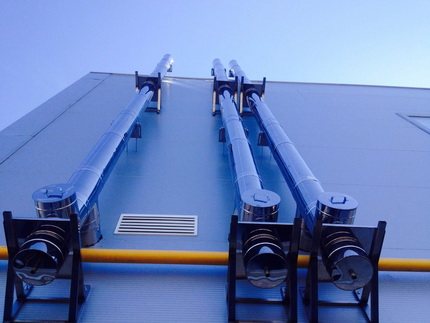
External chimney of coaxial type, vertical orientation. Such systems are quite easy to install
Installation of external structure
Before it starts, determine the exit point of the coaxial chimney and mark its location on the wall of the building. Then a hole is made in the wall with a diameter corresponding to the cross-section of the smoke exhaust duct.
Next, all internal work is carried out. They start by connecting the pipe to the heating device. For this, a single-circuit elbow and a double-circuit tee are used.
The latter is needed to secure the structure in a vertical position. The resulting structure is fixed to the wall surface with special brackets.
Further, all work is carried out similarly to the method described above. The chimney outlet section is sealed and pipe assembly continues to the desired height. The structure is secured to the wall with clamps. Adapter units are used to connect double-circuit pipes.
Where does condensation come from and why is it harmful?
Any fuel consists of flammable (carbon + hydrogen + sulfur) and non-flammable (oxygen + ash + water) components. When burned, hydrogen combines with oxygen to form water vapor. In addition, any fuel contains water (when burning anthracite, the flue gases contain up to 3% water vapor, and when burning wood of average humidity - up to 30% water vapor). When burning, flue gases passing through the chimney inevitably cool, water vapor on the walls of the chimney condenses (turns into water), dissolves soot, that is, combining with the products of fuel combustion in the boiler (in a gas boiler - CO, C02, NOx ; in liquid and solid fuel boilers and fireplaces, in addition to sulfur compounds), forms the corresponding acids or mixtures thereof. These acids include hydrochloric, nitric and sulfuric acids. In some cases, a mixture of them, the so-called “royal vodka,” may be formed. All this is condensate - a very aggressive black liquid with a very unpleasant odor.
